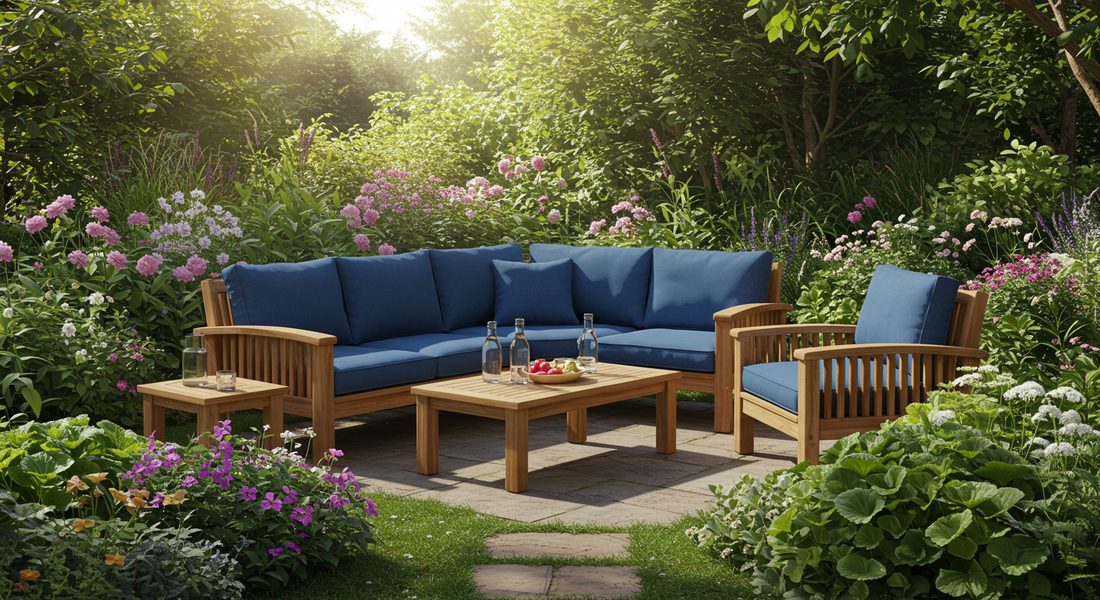
Outdoor Furniture Guide: How to Choose the Right Materials for Your Climate
Share

Choosing outdoor furniture is about finding the perfect blend of style and durability. While the look of a patio set is what first catches your eye, the material it's made from is the single most important factor in its longevity. The best outdoor furniture material for your home depends entirely on your local climate.
A chair that thrives in a dry, sunny desert climate might quickly fail in a rainy, humid one. Matching your furniture materials to your weather conditions is the key to creating a beautiful outdoor space that lasts for many seasons to come.
Material Breakdown: Pros and Cons
Understanding the strengths and weaknesses of each material will help you make an informed choice.
A. Natural Wood (Teak, Acacia, Cedar)
-
Pros: Wood offers a timeless, natural beauty that blends seamlessly into any garden. Teak is the king of outdoor woods; its high oil content makes it naturally resistant to rot and insects. Acacia and cedar are also excellent, durable options.
-
Cons: Wood requires the most maintenance. It needs to be regularly cleaned and sealed or oiled to maintain its color and prevent cracking. If left untreated, teak will weather to a silvery-gray patina, which many people find beautiful.
-
Best For: Most climates, but requires commitment to maintenance, especially in very wet or very sunny locations.
B. All-Weather Wicker (Resin Wicker)
-
Pros: All-weather wicker provides the classic, cozy look of natural wicker but is woven from a durable synthetic resin over an aluminum frame. This makes it highly resistant to moisture, UV rays, and rot, making it some of the most weather resistant patio furniture.
-
Cons: The quality can vary significantly. Cheaper, lower-quality resin can become brittle and crack over time. The woven texture can also trap dirt and requires occasional cleaning with a hose and soft brush. The teak vs wicker furniture debate often comes down to a choice between natural beauty and lower maintenance.
-
Best For: Humid, rainy climates and coastal areas, as it is resistant to moisture and salt air.
C. Metal (Aluminum, Wrought Iron, Stainless Steel)
-
Pros: Aluminum is the most popular choice for modern outdoor furniture. It's lightweight, rustproof, and can be powder-coated in any color. Wrought iron is incredibly heavy and sturdy, making it great for windy areas, but it can rust. Stainless steel is sleek and rust-resistant.
-
Cons: Metal can get very hot in direct sun. Wrought iron requires regular maintenance to prevent rust.
-
Best For: Aluminum is great for almost any climate. Wrought iron is best for climates without excessive rain.
D. Recycled Plastic (Polymer)
-
Pros: Made from recycled plastics like milk jugs, this material (often called polywood) is virtually indestructible. It's heavy, won't fade, requires no maintenance beyond simple cleaning, and comes in a huge variety of colors.
-
Cons: It can lack the high-end look of natural wood, and high-quality versions can be surprisingly expensive.
-
Best For: Any climate imaginable. It's perfect for extreme conditions, from scorching sun to freezing snow and salty coastal air.
Fabric and Cushion Considerations
The frame is only half the battle; the cushions need to be just as durable.
-
Solution-Dyed Acrylics: When it comes to outdoor fabric, brands like Sunbrella are the industry standard. They use solution-dyed acrylics, where the color is added to the fiber before it's spun into yarn. This makes the fabric incredibly resistant to fading from UV exposure.
-
Foam and Storage: Look for cushions with quick-dry foam that allows water to pass through easily. Even with weatherproof fabric, it's always best practice to store your cushions in a dry place or use furniture covers during heavy rain or the off-season to prolong their life.
Care and Maintenance
Here’s a simple guide for how to protect outdoor furniture:
|
Material |
Cleaning |
Protection |
|---|---|---|
|
Wood |
Mild soap and water. |
Annual sealing or oiling. |
|
Wicker |
Hose down, soft brush. |
Cover in winter to prevent cracking in freezing temps. |
|
Aluminum |
Mild soap and water. |
Touch up paint on scratches if needed. |
|
Plastic |
Soap and water, power wash on low. |
No protection needed. |
Conclusion: Choosing Furniture That Lasts
Investing in high-quality outdoor furniture made from a material suited to your climate is the key to creating an outdoor oasis you can enjoy for many years. By understanding the pros and cons of each material and committing to a simple maintenance routine, you can ensure your patio furniture remains as beautiful as the day you bought it.
